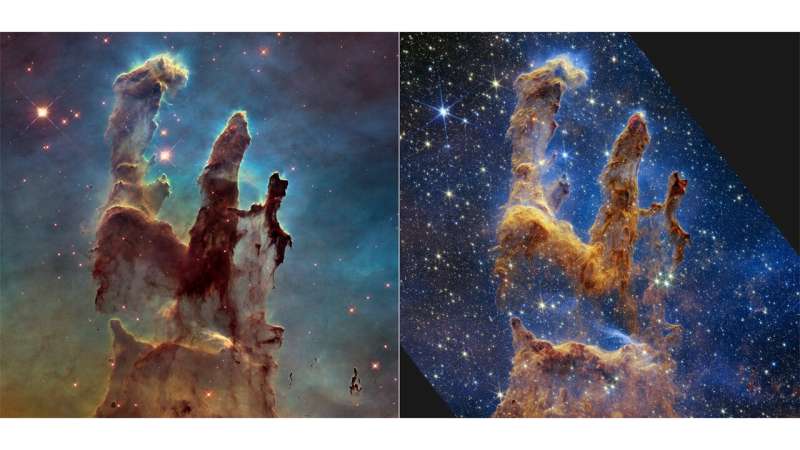NASA's Hubble Space Telescope made the Pillars of Creation famous with its first image in 1995, but revisited the scene in 2014 to reveal a sharper, wider view in visible light, shown above at left. A new, near-infrared-light view from NASA's James Webb Space Telescope, at right, helps us peer through more of the dust in this star-forming region. The thick, dusty brown pillars are no longer as opaque and many more red stars that are still forming come into view. While the pillars of gas and dust seem darker and less penetrable in Hubble's view, they appear more diaphanous in Webb's. The background of this Hubble image is like a sunrise, beginning in yellows at the bottom, before transitioning to light green and deeper blues at the top. These colors highlight the thickness of the dust all around the pillars, which obscures many more stars in the overall region. In contrast, the background light in Webb's image appears in blue hues, which highlights the hydrogen atoms, and reveals an abundance of stars spread across the scene. By penetrating the dusty pillars, Webb also allows us to identify stars that have recently—or are about to—burst free. Near-infrared light can penetrate thick dust clouds, allowing us to learn so much more about this incredible scene. Both views show us what is happening locally. Although Hubble highlights many more thick layers of dust and Webb shows more of the stars, neither shows us the deeper universe. Dust blocks the view in Hubble's image, but the interstellar medium plays a major role in Webb's. It acts like thick smoke or fog, preventing us from peering into the deeper universe, where countless galaxies exist. The pillars are a small region within the Eagle Nebula, a vast star-forming region 6,500 light-years from Earth. Credit: NASA, ESA, CSA, STScI, Hubble Heritage Project (STScI, AURA)
NASA's James Webb Space Telescope has captured a lush, highly detailed landscape—the iconic Pillars of Creation—where new stars are forming within dense clouds of gas and dust. The three-dimensional pillars look like majestic rock formations, but are far more permeable. These columns are made up of cool interstellar gas and dust that appear—at times—semi-transparent in near-infrared light.
Webb's new view of the Pillars of Creation, which were first made famous when imaged by NASA's Hubble Space Telescope in 1995, will help researchers revamp their models of star formation by identifying far more precise counts of newly formed stars, along with the quantities of gas and dust in the region. Over time, they will begin to build a clearer understanding of how stars form and burst out of these dusty clouds over millions of years.
Newly formed stars are the scene-stealers in this image from Webb's Near-Infrared Camera (NIRCam). These are the bright red orbs that typically have diffraction spikes and lie outside one of the dusty pillars. When knots with sufficient mass form within the pillars of gas and dust, they begin to collapse under their own gravity, slowly heat up, and eventually form new stars.
What about those wavy lines that look like lava at the edges of some pillars? These are ejections from stars that are still forming within the gas and dust. Young stars periodically shoot out supersonic jets that collide with clouds of material, like these thick pillars. This sometimes also results in bow shocks, which can form wavy patterns like a boat does as it moves through water. The crimson glow comes from the energetic hydrogen molecules that result from jets and shocks. This is evident in the second and third pillars from the top—the NIRCam image is practically pulsing with their activity. These young stars are estimated to be only a few hundred thousand years old.
Although it may appear that near-infrared light has allowed Webb to "pierce through" the clouds to reveal great cosmic distances beyond the pillars, there are no galaxies in this view. Instead, a mix of translucent gas and dust known as the interstellar medium in the densest part of our Milky Way galaxy's disk blocks our view of the deeper universe.
This scene was first imaged by Hubble in 1995 and revisited in 2014, but many other observatories have also stared deeply at this region. Each advanced instrument offers researchers new details about this region, which is practically overflowing with stars.
Provided by NASA























